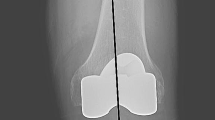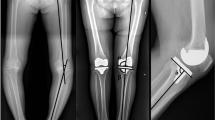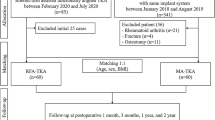Abstract
This study aimed to assess the preliminary outcomes of kinematically aligned robot-assisted total knee arthroplasty (TKA) with patient-specific cartilage thickness measurement. Patients who underwent kinematically aligned robot-assisted TKA were included in this study. Robot-assisted total knee arthroplasties were performed by NAVIO Surgical System (Smith & Nephew, Memphis, USA), an image-free handheld robotic system. The kinematic alignment technique was performed according to our intraoperative cartilage thickness measurement technique. Hip-knee-ankle angle (HKA), mechanical lateral distal femoral angle (mLDFA), mechanical medial proximal tibial angle (mMPTA), joint-line orientation angle (JLOA), and joint-line convergence angle (JLCA) were measured through standing full-length anteroposterior radiographs. Knee Injury and Osteoarthritis Outcome Score, Oxford score, VAS pain and satisfaction score, and Forgotten Joint Score were used to assess clinical outcomes. A total of 142 knees of 109 patients (92 females and 17 males) were evaluated in this study. There was a significant correction in HKA, JLCA, and mMPTA postoperatively (p ≤0.001, < 0.001, and 0.029, respectively). We observed no significant change in mLDFA and JLOA measurements. All clinical scores significantly increased at the latest follow-up. Our results demonstrated that kinematically aligned robot-assisted TKA with patient-specific cartilage thickness measurement demonstrated no significant change in mLDFA and JLOA, as expected; however, significantly corrected the deformity in HKA, mMPTA, and JLCA measurements.



Similar content being viewed by others
Data availability
The datasets generated during and/or analyzed during the current study are available from the corresponding author upon reasonable request.
References
Chang J, Liao Z, Lu M, Meng T, Han W, Ding C (2018) Systemic and local adipose tissue in knee osteoarthritis. Osteoarthritis Cartilage 26(7):864–871. https://doi.org/10.1016/j.joca.2018.03.004
Nisar S, Palan J, Rivière C, Emerton M, Pandit H (2020) Kinematic alignment in total knee arthroplasty. EFORT Open Rev 5(7):380–390. https://doi.org/10.1302/2058-5241.5.200010
Howell SM, Hull ML (2012) Kinematic alignment in total knee arthroplasty. In: Scott WN (ed) Insall and Scott surgery of the knee. Elsevier, Philadelphia, pp 1255–1268
Howell SM, Howell SJ, Kuznik KT, Cohen J, Hull ML (2013) Does a kinematically aligned total knee arthroplasty restore function without failure regardless of alignment category? Clin Orthop Relat Res 471(3):1000–1007. https://doi.org/10.1007/s11999-012-2613-z
Nam D, Lin KM, Howell SM, Hull ML (2014) Femoral bone and cartilage wear is predictable at 0° and 90° in the osteoarthritic knee treated with total knee arthroplasty. Knee Surg Sports Traumatol Arthrosc 22(12):2975–2981. https://doi.org/10.1007/s00167-014-3080-8
Nam JH, Koh YG, Kim PS, Park JH, Kang KT (2020) Effect of the presence of the articular cartilage on the femoral component rotation in total knee arthroplasty in female and varus osteoarthritis knees. J Orthop Surg Res 15(1):499. https://doi.org/10.1186/s13018-020-02030-9
Bell C, Grau L, Orozco F, Ponzio D, Post Z, Czymek M, Ong A (2021) The successful implementation of the Navio robotic technology required cases. J Robot Surg. https://doi.org/10.1007/s11701-021-01254-z
Vaidya N, Jaysingani TN, Panjwani T, Patil R, Deshpande A, Kesarkar A (2022) Assessment of accuracy of an imageless hand-held robotic-assisted system in component positioning in total knee replacement: a prospective study. J Robot Surg 16(2):361–367. https://doi.org/10.1007/s11701-021-01249-w
Ji HM, Han J, Jin DS, Seo H, Won YY (2016) Kinematically aligned TKA can align knee joint line to horizontal. Knee Surg Sports Traumatol Arthrosc 24(8):2436–2441. https://doi.org/10.1007/s00167-016-3995-3
Kleeblad LJ, van der List JP, Pearle AD, Fragomen AT, Rozbruch SR (2018) Predicting the feasibility of correcting mechanical axis in large varus deformities with unicompartmental knee arthroplasty. J Arthroplasty 33(2):372–378. https://doi.org/10.1016/j.arth.2017.09.052
Dossett HG, Estrada NA, Swartz GJ, LeFevre GW, Kwasman BG (2014) A randomised controlled trial of kinematically and mechanically aligned total knee replacements: two-year clinical results. Bone Joint J 96-B(7):907–913
Waterson HB, Clement ND, Eyres KS, Mandalia VI, Toms AD (2016) The early outcome of kinematic versus mechanical alignment in total knee arthroplasty: a prospective randomised control trial. Bone Joint J 98-B:1360–1368
Young SW, Sullivan NPT, Walker ML, Holland S, Bayan A, Farrington B (2020) No difference in 5-year clinical or radiographic outcomes between kinematic and mechanical alignment in TKA: a randomized controlled trial. Clin Orthop Relat Res 478(6):1271–1279
Calliess T, Bauer K, Stukenborg-Colsman C, Windhagen H, Budde S, Ettinger M (2017) PSI kinematic versus non-PSI mechanical alignment in total knee arthroplasty: a prospective, randomized study. Knee Surg Sports Traumatol Arthrosc 25(6):1743–1748
Laende EK, Richardson CG, Dunbar MJ (2019) A randomized controlled trial of tibial component migration with kinematic alignment using patient-specific instrumentation versus mechanical alignment using computer-assisted surgery in total knee arthroplasty. Bone Joint J 101-B(8):929–940
MacDessi SJ, Griffiths-Jones W, Chen DB, Griffiths-Jones S, Wood JA, Diwan AD, Harris IA (2020) Restoring the constitutional alignment with a restrictive kinematic protocol improves quantitative soft-tissue balance in total knee arthroplasty: a randomized controlled trial. Bone Joint J 102-B(1):117–124
McNair PJ, Boocock MG, Dominick ND, Kelly RJ, Farrington BJ, Young SW (2018) A Comparison of walking gait following mechanical and kinematic alignment in total knee joint replacement. J Arthroplasty 33(2):560–564
McEwen PJ, Dlaska CE, Jovanovic IA, Doma K, Brandon BJ (2020) Computer-assisted kinematic and mechanical axis total knee arthroplasty: a prospective randomized controlled trial of bilateral simultaneous surgery. J Arthroplasty 35(2):443–450
Yeo JH, Seon JK, Lee DH, Song EK (2019) No difference in outcomes and gait analysis between mechanical and kinematic knee alignment methods using robotic total knee arthroplasty. Knee Surg Sports Traumatol Arthrosc 27(4):1142–1147
Matsumoto T, Takayama K, Ishida K, Hayashi S, Hashimoto S, Kuroda R (2017) Radiological and clinical comparison of kinematically versus mechanically aligned total knee arthroplasty. Bone Joint J 99-B(5):640–646
Bellemans J, Colyn W, Vandenneucker H, Victor J (2012) The Chitranjan Ranawat award: is neutral mechanical alignment normal for all patients? The concept of constitutional varus. Clin Orthop Relat Res 470(1):45–53. https://doi.org/10.1007/s11999-011-1936-5
Almaawi AM, Hutt JRB, Masse V, Lavigne M, Vendittoli PA (2017) The impact of mechanical and restricted kinematic alignment on knee anatomy in total knee arthroplasty. J Arthroplasty 32(7):2133–2140. https://doi.org/10.1016/j.arth.2017.02.028
D’Amato M, Kosse NM, Wymenga AB (2021) Restoration of pre-operative joint line orientation and alignment does not affect KSS and KOOS 1 year after total knee arthroplasty. Knee Surg Sports Traumatol Arthrosc 29(10):3170–3177. https://doi.org/10.1007/s00167-020-06097-z
Calek AK, Ladurner A, Jud L, Zdravkovic V, Behrend H (2022) Tibial joint line orientation has no effect on joint awareness after mechanically aligned total knee arthroplasty. Knee Surg Sports Traumatol Arthrosc 30(2):389–396. https://doi.org/10.1007/s00167-021-06696-4
Shin KH, Jang KM, Han SB (2022) Residual varus alignment can reduce joint awareness, restore joint parallelism, and preserve the soft tissue envelope during total knee arthroplasty for varus osteoarthritis. Knee Surg Sports Traumatol Arthrosc 30(2):507–516. https://doi.org/10.1007/s00167-020-06201-3
Elbuluk AM, Jerabek SA, Suhardi VJ, Sculco PK, Ast MP, Vigdorchik JM (2022) Head-to-head comparison of kinematic alignment versus mechanical alignment for total knee arthroplasty. J Arthroplasty. https://doi.org/10.1016/j.arth.2022.01.052
Singh V, Fiedler B, Simcox T, Aggarwal VK, Schwarzkopf R, Meftah M (2021) Does the use of intraoperative technology yield superior patient outcomes following total knee arthroplasty? J Arthroplasty 36(7S):S227–S232. https://doi.org/10.1016/j.arth.2020.11.001
Singh V, Fiedler B, Huang S, Oh C, Karia RJ, Schwarzkopf R (2022) Patient acceptable symptom state for the forgotten joint score in primary total knee arthroplasty. J Arthroplasty. https://doi.org/10.1016/j.arth.2022.03.069
Peersman G, Verhaegen J, Favier B (2019) The forgotten joint score in total and unicompartmental knee arthroplasty: a prospective cohort study. Int Orthop 43(12):2739–2745. https://doi.org/10.1007/s00264-019-04342-w
Zuiderbaan HA, van der List JP, Khamaisy S, Nawabi DH, Thein R, Ishmael C, Paul S, Pearle AD (2017) Unicompartmental knee arthroplasty versus total knee arthroplasty: Which type of artificial joint do patients forget? Knee Surg Sports Traumatol Arthrosc 25(3):681–686. https://doi.org/10.1007/s00167-015-3868-1
Acknowledgements
There is no acknowledgement.
Funding
The authors declare that no funds, grants, or other support were received during the preparation of this manuscript.
Author information
Authors and Affiliations
Contributions
All authors contributed to the study conception and design. Material preparation, data collection and analysis were performed by [MK], [YU], [YOK] and [AT]. The first draft of the manuscript was written by [KT] and [YC] and all authors commented on previous versions of the manuscript. All authors read and approved the final manuscript.
Corresponding author
Ethics declarations
Competing interests
The authors declare no competing interests.
Conflict of interest
The authors have no relevant financial or non-financial interests to disclose.
Ethical approval
This study was performed in line with the principles of the Declaration of Helsinki. Approval was granted by the Ethics Committee of Istanbul Atlas University (Date: 25.06.2021/No: E-22686390-050.01.04-4761).
Informed consent
Informed consent was obtained from all individual participants included in the study.
Additional information
Publisher's Note
Springer Nature remains neutral with regard to jurisdictional claims in published maps and institutional affiliations.
Rights and permissions
Springer Nature or its licensor (e.g. a society or other partner) holds exclusive rights to this article under a publishing agreement with the author(s) or other rightsholder(s); author self-archiving of the accepted manuscript version of this article is solely governed by the terms of such publishing agreement and applicable law.
About this article
Cite this article
Turan, K., Camurcu, Y., Kezer, M. et al. Preliminary outcomes of kinematically aligned robot-assisted total knee arthroplasty with patient-specific cartilage thickness measurement. J Robotic Surg 17, 979–985 (2023). https://doi.org/10.1007/s11701-022-01503-9
Received:
Accepted:
Published:
Issue Date:
DOI: https://doi.org/10.1007/s11701-022-01503-9




